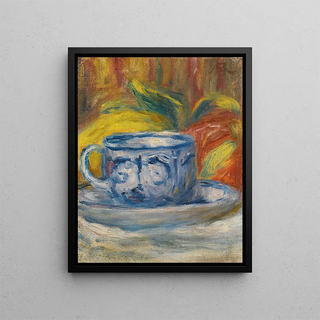Art print | Cup and Fruits - Pierre-Auguste Renoir


View from behind

Frame (optional)
Nature morte, often perceived as a simple assembly of inanimate objects, transcends this definition in the iconic work by Pierre-Auguste Renoir, titled "Tasse et fruits". This vibrant composition, where light caresses the forms, reveals a sensory intimacy that invites the viewer to immerse themselves in a moment of contemplation. Renoir, master of Impressionism, manages to capture the ephemeral and transform it into a lasting visual experience. In this piece, the delicate cup and juicy fruits are not merely objects but actors in a scene where the beauty of everyday life is celebrated.
Style and uniqueness of the work
The uniqueness of "Tasse et fruits" lies in how Renoir plays with light and color. Warm, vibrant hues intertwine to create an almost tactile atmosphere, where each fruit seems ready to reveal its sweet juice. The cup, adorned with delicate patterns, stands proudly among the fruits, symbolizing the harmony between craftsmanship and nature. Renoir uses fluid, expressive brushstrokes, characteristic of his style, which breathe life into the scene. This painting does not just depict objects; it evokes a sense of warmth, conviviality, and wonder at the beauty of simple things. The composition, balanced and harmonious, invites prolonged contemplation, allowing each detail to gradually reveal itself to the viewer.
The artist and his influence
Pierre-Auguste Renoir, an emblematic figure of Impressionism, profoundly influenced art history with his ability to capture the essence of modern life. Born in 1841, he evolved through various artistic movements while remaining faithful to his personal vision. Renoir is interested in the pleasures of life, the beauty of everyday scenes, and the light that transforms the world. His influence extends far beyond his era and has inspired many artists to explore color and light boldly. Through "Tasse et fruits", Renoir demonstrates his talent for transcending the banal and transforming it into art, a legacy that continues to

Matte finish

View from behind

Frame (optional)
Nature morte, often perceived as a simple assembly of inanimate objects, transcends this definition in the iconic work by Pierre-Auguste Renoir, titled "Tasse et fruits". This vibrant composition, where light caresses the forms, reveals a sensory intimacy that invites the viewer to immerse themselves in a moment of contemplation. Renoir, master of Impressionism, manages to capture the ephemeral and transform it into a lasting visual experience. In this piece, the delicate cup and juicy fruits are not merely objects but actors in a scene where the beauty of everyday life is celebrated.
Style and uniqueness of the work
The uniqueness of "Tasse et fruits" lies in how Renoir plays with light and color. Warm, vibrant hues intertwine to create an almost tactile atmosphere, where each fruit seems ready to reveal its sweet juice. The cup, adorned with delicate patterns, stands proudly among the fruits, symbolizing the harmony between craftsmanship and nature. Renoir uses fluid, expressive brushstrokes, characteristic of his style, which breathe life into the scene. This painting does not just depict objects; it evokes a sense of warmth, conviviality, and wonder at the beauty of simple things. The composition, balanced and harmonious, invites prolonged contemplation, allowing each detail to gradually reveal itself to the viewer.
The artist and his influence
Pierre-Auguste Renoir, an emblematic figure of Impressionism, profoundly influenced art history with his ability to capture the essence of modern life. Born in 1841, he evolved through various artistic movements while remaining faithful to his personal vision. Renoir is interested in the pleasures of life, the beauty of everyday scenes, and the light that transforms the world. His influence extends far beyond his era and has inspired many artists to explore color and light boldly. Through "Tasse et fruits", Renoir demonstrates his talent for transcending the banal and transforming it into art, a legacy that continues to






